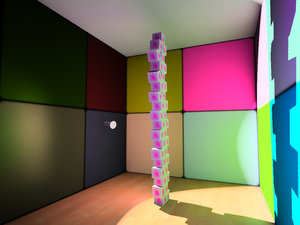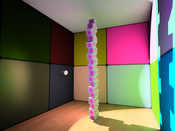Information
- Publication Type: Master Thesis
- Workgroup(s)/Project(s):
- Date: July 2009
- Diploma Examination: 28. July 2009
- First Supervisor:
- Keywords: Real Time Rendering, Global Illumination, Instant Radiosity, Temporal Coherence
Abstract
The goal of this thesis is to produce plausible global illumination in real time using temporal coherence. While direct illumination combined with precomputed static global illumination is widely used in today’s computer games and 3D applications, real-time global illumination that supports arbitrary dynamic scenes and light setups is still an active area of research. This master thesis gives an introduction to global illumination and discusses various methods that have been developed. However, since most of the existing methods need some kind of precomputation to calculate global illumination in real time, they also introduce limitations like static light, scenes or view points. Furthermore other algorithms are not suitable for the capabilities of current graphics hardware or are simply fake approaches. The core of this thesis is an improved version of the instant radiosity and imperfect shadow maps algorithm that reuses illumination information from previous frames. The previous approaches needed a high number of so called virtual point lights to get convincing results, whereas our method achieves visually pleasing results with only a few virtual point lights. As a second extension to the base algorithms we introduce a new method to compute multiple light bounces. In this method the fill rate is drastically reduced and therefore computation time is much lower than in previous aproaches.Additional Files and Images
Weblinks
No further information available.BibTeX
@mastersthesis{knecht-2009-MKN,
title = "Real-Time Global Illumination Using Temporal Coherence",
author = "Martin Knecht",
year = "2009",
abstract = "The goal of this thesis is to produce plausible global
illumination in real time using temporal coherence. While
direct illumination combined with precomputed static global
illumination is widely used in today’s computer games and
3D applications, real-time global illumination that supports
arbitrary dynamic scenes and light setups is still an active
area of research. This master thesis gives an introduction
to global illumination and discusses various methods that
have been developed. However, since most of the existing
methods need some kind of precomputation to calculate global
illumination in real time, they also introduce limitations
like static light, scenes or view points. Furthermore other
algorithms are not suitable for the capabilities of current
graphics hardware or are simply fake approaches. The core of
this thesis is an improved version of the instant radiosity
and imperfect shadow maps algorithm that reuses illumination
information from previous frames. The previous approaches
needed a high number of so called virtual point lights to
get convincing results, whereas our method achieves visually
pleasing results with only a few virtual point lights. As a
second extension to the base algorithms we introduce a new
method to compute multiple light bounces. In this method the
fill rate is drastically reduced and therefore computation
time is much lower than in previous aproaches.",
month = jul,
address = "Favoritenstrasse 9-11/E193-02, A-1040 Vienna, Austria",
school = "Institute of Computer Graphics and Algorithms, Vienna
University of Technology ",
keywords = "Real Time Rendering, Global Illumination, Instant Radiosity,
Temporal Coherence",
URL = "https://www.cg.tuwien.ac.at/research/publications/2009/knecht-2009-MKN/",
}

 poster
poster thesis
thesis


